With Stevenson through the Cevennes |
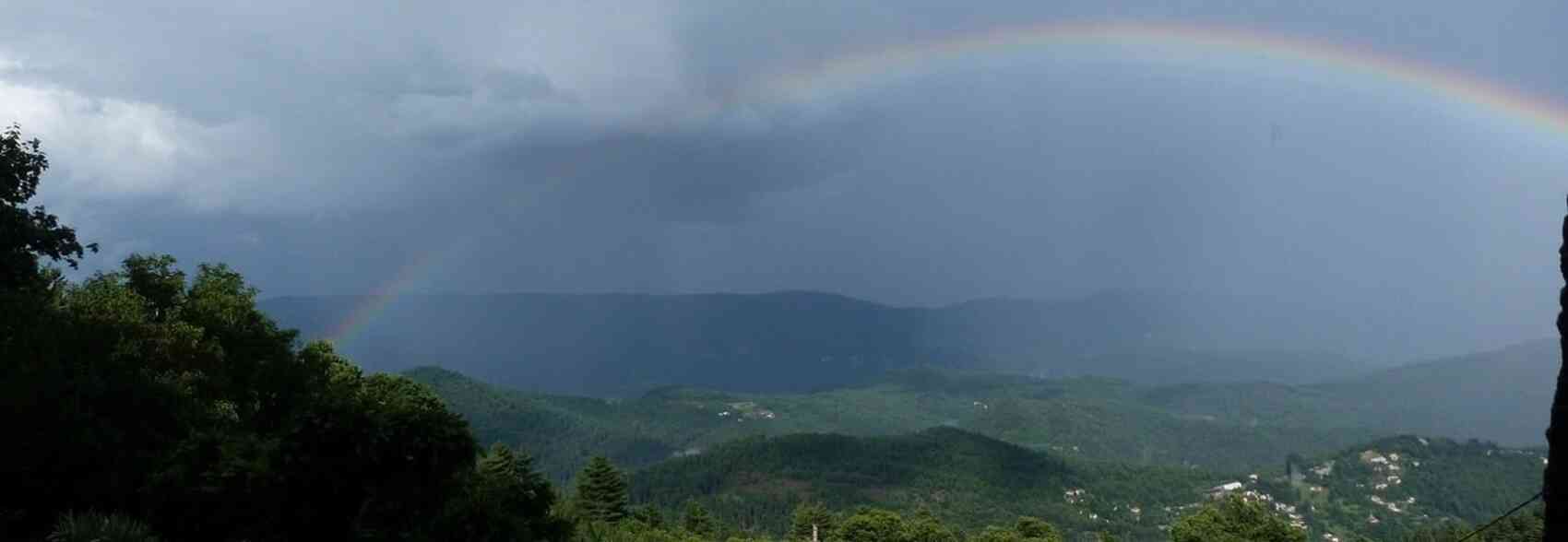
 At the end of the last century, R.L. Stevenson, a Scottish writer, embarked on a solo journey through the Cévennes in search of the Camisard soul. Starting from Monastier-sur-Gazeille with only a donkey as his companion, he would end up in Saint-Jean-du-Gard after a colorful adventure that he detailed in a book titled "Travels with a Donkey in the Cévennes." It is the Lozère part of this journey that we invite you to follow.
At the end of the last century, R.L. Stevenson, a Scottish writer, embarked on a solo journey through the Cévennes in search of the Camisard soul. Starting from Monastier-sur-Gazeille with only a donkey as his companion, he would end up in Saint-Jean-du-Gard after a colorful adventure that he detailed in a book titled "Travels with a Donkey in the Cévennes." It is the Lozère part of this journey that we invite you to follow.
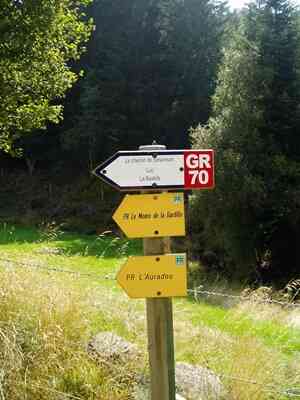 By car, on foot, on horseback, with a donkey: all solutions are good depending on the time you have. The proposed stages are all of high quality and will allow you to experience intensely the paths you will traverse. And don't forget the key book for this pilgrimage in the footsteps of Stevenson! 1878... it seems so far away. Yet today, it is still 1878. Everything is the same.
By car, on foot, on horseback, with a donkey: all solutions are good depending on the time you have. The proposed stages are all of high quality and will allow you to experience intensely the paths you will traverse. And don't forget the key book for this pilgrimage in the footsteps of Stevenson! 1878... it seems so far away. Yet today, it is still 1878. Everything is the same.
All the mentioned places are there, in reality! The buildings, the streets, the paths... Of course, the heroine is missing, the donkey Modestine. She is no longer of this world. She apparently did not leave behind, like her master, any written account meant to immortalize her character. But such is the calling of the immense soul of a very small donkey who was scorned, ridiculed, harassed, and exhausted. Modestine, becoming less combative as the pages turn, increasingly invades the emotional universe of the narrator, changing his view of himself and of his "Cévennes".
From explanatory adventures, didactic demonstrations that initiate this journal, we quickly move towards a more sensual, impressionistic landscape reading, but also more initiatory. The logic, the construction of the work, all trembles and fades away in a progressively more intimate journey. Scents, colors, and sounds, of course, but also touch and taste, constitute the essentials of our journey through this Gévaudan.
For it must be said, this is a highly literary journey... and fundamentally funny, moreover. It is a quest for the impossible journey. It is an accumulation, a stacking of very Scottish misadventures in our beautiful Gévaudan country. Could one not even think that it is outright provocation? For why, Good Heavens, start a journey on foot at the beginning of winter, in the highest and most unpredictable part of Lozère, when it begins to shed its luminous autumn attire for the first chills, its mists, and some pearls of rain?
So it is in a time of year with rather uncertain weather that our hero takes the road descending from Monastier-sur-Gazeille towards Langogne. The road? Let's say more like goat paths that his donkey guide determines with a gently stubborn obstinacy. For Modestine, she's a tough one; a head filled with poetic, emotional, and gustatory projects. And what she concocts in her head, she wants to knit right away with her little legs. In a tight flow! Apparently, Robert Louis Stevenson's plans do not necessarily find their way... Thus, the Cévennes, wintertime, on foot, with a donkey, and also a load. And a load worthy of an Englishman from an image of Epinal. One who would have signed Prévert:
a frying pan,
a whisk,
a sleeping bag,
a cooked leg of lamb,
an alcohol lamp.
a bottle of Beaujolais
another of Brandy
and plenty, plenty of ropes...
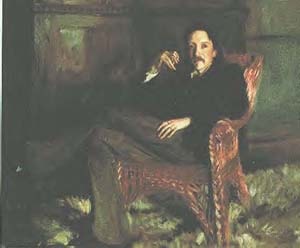 For the packing and the ropes are the two pillars of the journey. It is even the heart of this adventure. It is the Gordian knot to untie. And like every Gordian knot, one must cut through to move forward. Farewell then frying pan, leg of lamb, Beaujolais, and white bread. VicitAsinus. From then on, everything is ready to get to the essentials, in the fog and at the heart of the fog of things. Are we comfortable, uncomfortable at the local inn? Is it wise to sleep there? In any case, one is either freezing or the subject of mockery. Sometimes both at the same time when luck finally smiles upon you! Our glorious author would have disregarded all these avatars if the metaphysical quarrels involving monks and converted Irishmen had not disturbed him somewhat at the Notre-Dame-des-Neiges abbey. But how can a Scottish convenantist imagine without shivering to spend a night in a papist monastery? It is to throw oneself into the wolf's den. Dangerous in the Land of the Beast, a meeting always dreaded, but perhaps always desired... For, after all, is the avowed purpose of this journey not the encounter with the Camisard Cévennes, the mysterious, and perhaps still dangerous?
For the packing and the ropes are the two pillars of the journey. It is even the heart of this adventure. It is the Gordian knot to untie. And like every Gordian knot, one must cut through to move forward. Farewell then frying pan, leg of lamb, Beaujolais, and white bread. VicitAsinus. From then on, everything is ready to get to the essentials, in the fog and at the heart of the fog of things. Are we comfortable, uncomfortable at the local inn? Is it wise to sleep there? In any case, one is either freezing or the subject of mockery. Sometimes both at the same time when luck finally smiles upon you! Our glorious author would have disregarded all these avatars if the metaphysical quarrels involving monks and converted Irishmen had not disturbed him somewhat at the Notre-Dame-des-Neiges abbey. But how can a Scottish convenantist imagine without shivering to spend a night in a papist monastery? It is to throw oneself into the wolf's den. Dangerous in the Land of the Beast, a meeting always dreaded, but perhaps always desired... For, after all, is the avowed purpose of this journey not the encounter with the Camisard Cévennes, the mysterious, and perhaps still dangerous?
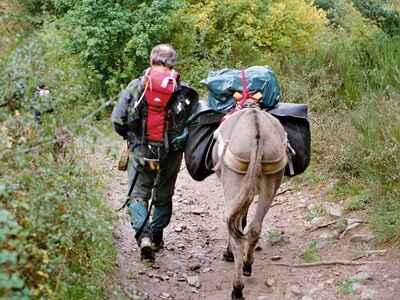 In 1878, the writer Robert Louis Stevenson, known for works such as Treasure Island and The Strange Case of Dr Jekyll and Mr Hyde, undertook a twelve-day hiking journey accompanied by Modestine, his faithful donkey. He started from the village of Monastier-sur-Gazeille, a little south of Puy-en-Velay. However, we began our own adventure in La Bastide-Puylaurent, on the border between Vivarais and the Cévennes. Over the course of seven days, we will follow Stevenson's footsteps, crossing Mont Lozère and reaching the small town of Saint-Jean-du-Gard in the south.
In 1878, the writer Robert Louis Stevenson, known for works such as Treasure Island and The Strange Case of Dr Jekyll and Mr Hyde, undertook a twelve-day hiking journey accompanied by Modestine, his faithful donkey. He started from the village of Monastier-sur-Gazeille, a little south of Puy-en-Velay. However, we began our own adventure in La Bastide-Puylaurent, on the border between Vivarais and the Cévennes. Over the course of seven days, we will follow Stevenson's footsteps, crossing Mont Lozère and reaching the small town of Saint-Jean-du-Gard in the south.
How did a Scottish author like Stevenson (1850 - 1894) end up in this remote region that still retains a certain charm of isolation today? Well, it all started with a broken heart. He had fallen in love with an American named Fanny Osbourne, but she remained out of reach (though he eventually married her later). His family doctor and friend advised him to take a break and clear his mind. To find solace, he went to the countryside, which led him to Monastier-sur-Gazeille. After a few weeks, he grew bored and decided to embark on a hiking adventure through the Cévennes. For 65 old French francs and a glass of cognac, he bought a donkey from a local farmer to carry his belongings. He walked through Velay, Gévaudan, and Vivarais, crossing Mont Lozère until he reached Saint-Jean-du-Gard. In Stevenson's time, it was a true adventure. He sometimes stayed with farmers, other times slept under the stars. He frequently got lost, but along the way, he also had unexpected encounters. In 1879, the book "Travels with a Donkey in the Cévennes" was published, and it has since been translated into French several times.
 The Stevenson path, once a simple regional trail, was recognized in 1994 and became the GR®70. Since then, many changes have taken place: topographic maps have been adapted, some hostels have closed while others have taken their place. But the route is now well-marked and hard to get lost. Due to lack of time, this time we will follow the Stevenson path through the Cévennes starting from La Bastide-Puylaurent. This small village is located on the D 906 between Langogne and Alès. It gained importance during the construction of the "Le Cévenol" railway line. It is situated at an altitude of 100 meters, between Vivarais (Ardèche) and the Cévennes, in the department of Lozère. As usual, we settle in the guesthouse "L'Etoile," with Philippe Papadimitriou, who warmly welcomes us. Philippe sits down at the piano and tries to produce beautiful melodies. The fire in the fireplace crackles and Billy, the dog, wags his tail.
The Stevenson path, once a simple regional trail, was recognized in 1994 and became the GR®70. Since then, many changes have taken place: topographic maps have been adapted, some hostels have closed while others have taken their place. But the route is now well-marked and hard to get lost. Due to lack of time, this time we will follow the Stevenson path through the Cévennes starting from La Bastide-Puylaurent. This small village is located on the D 906 between Langogne and Alès. It gained importance during the construction of the "Le Cévenol" railway line. It is situated at an altitude of 100 meters, between Vivarais (Ardèche) and the Cévennes, in the department of Lozère. As usual, we settle in the guesthouse "L'Etoile," with Philippe Papadimitriou, who warmly welcomes us. Philippe sits down at the piano and tries to produce beautiful melodies. The fire in the fireplace crackles and Billy, the dog, wags his tail.
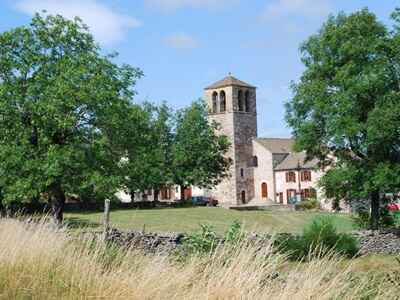 The next day, rested from our long journey, we set off immediately. In reality, Stevenson followed the D 6, which at the time was a cart track, towards Chasseradès. Now, the trail winds through hills, amid woods. We spot the markings near the station, cross the tracks, and continue climbing through the woods following GR®70. After following a wide country road, the ascent lasts about an hour until we reach the top of the day, Le Moure de la Gardille, at an altitude of 1308 meters. The woods disappear, and we walk on a plateau of meadows and bushes offering magnificent views in all directions. We gradually descend and reconnect with the D 6. We first reach the station (line La Bastide - Mende), then arrive at Chasseradès. Although the place has a few good hotels, the bakery-grocery has closed. We then continue our walk on a rocky path passing through Mirandol (Gîte d'étape de Mirandol) heading towards L'Estampe. Le Bleymard is still 10 kilometers away (or nearly three hours of walking).
The next day, rested from our long journey, we set off immediately. In reality, Stevenson followed the D 6, which at the time was a cart track, towards Chasseradès. Now, the trail winds through hills, amid woods. We spot the markings near the station, cross the tracks, and continue climbing through the woods following GR®70. After following a wide country road, the ascent lasts about an hour until we reach the top of the day, Le Moure de la Gardille, at an altitude of 1308 meters. The woods disappear, and we walk on a plateau of meadows and bushes offering magnificent views in all directions. We gradually descend and reconnect with the D 6. We first reach the station (line La Bastide - Mende), then arrive at Chasseradès. Although the place has a few good hotels, the bakery-grocery has closed. We then continue our walk on a rocky path passing through Mirandol (Gîte d'étape de Mirandol) heading towards L'Estampe. Le Bleymard is still 10 kilometers away (or nearly three hours of walking).
On the second day of our hike (from L'Estampe to the Mont Lozère station), we begin by crossing the Goulet state forest, a wood with varied species spanning about 1250 hectares. Therefore, it takes some time to reach the view of Le Bleymard. Here, one must be vigilant. At first, the Mont Lozère Tour and the Stevenson path follow the same direction. The former crosses the entire village and then goes west. Our path, however, takes a small street to the left just before the center of the village (marked by the sign "La Fontaine") to ascend to the south and Mont Lozère. The climb is gradual until we reach a clear area, the Mont Lozère ski resort. The wind blows freely here, and it can be much cooler. The northern slope of Mont Lozère is known for its rather harsh climate. For safety, most houses have their entrance on the south side.
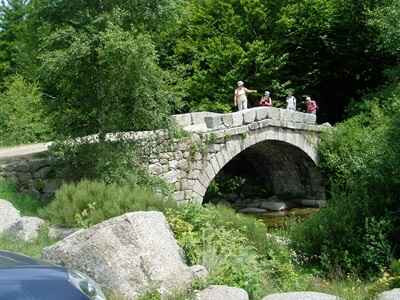 We are still far from the summit of Mont Lozère, but we will reach it during the third stage of our journey. As we cross the meadows, we follow a draille, a path used by sheep herds during their annual transhumance to higher pastures. In mid-June, they leave the southern valleys where the grass is already dry and grazed, for a journey of eight to nine days in search of food further north. Mont Lozère is also a regular resting place for herds. In the past, there were more than 200,000 heads of sheep, but today it is considered lucky to come across flocks of a thousand sheep. The highest point of Mont Lozère, and of our entire journey, is the summit of Finiels, which reaches 1699 meters above sea level. Then we descend into the woods and follow a rocky path to reach the next stage, Le Pont de Monvert.
We are still far from the summit of Mont Lozère, but we will reach it during the third stage of our journey. As we cross the meadows, we follow a draille, a path used by sheep herds during their annual transhumance to higher pastures. In mid-June, they leave the southern valleys where the grass is already dry and grazed, for a journey of eight to nine days in search of food further north. Mont Lozère is also a regular resting place for herds. In the past, there were more than 200,000 heads of sheep, but today it is considered lucky to come across flocks of a thousand sheep. The highest point of Mont Lozère, and of our entire journey, is the summit of Finiels, which reaches 1699 meters above sea level. Then we descend into the woods and follow a rocky path to reach the next stage, Le Pont de Monvert.
Located in a deeply enclosed valley where the Tarn winds, Le Pont de Monvert is especially known for its narrow Donkeys' Bridge and a few old dwellings. The town also has historical significance, as it is where the long struggle between the King's Dragons and the Protestant Camisards began. In 1702, Camisards assassinated Abbé Chayla here, a pivotal event of this period.
 Indeed, the period of the religious wars in France left deep marks on the country's history. In the 16th century, vast regions of France were of Protestant faith. However, some influential members of the French king's court opposed this situation, leading to the tragic event of the St. Bartholomew's Night in 1572. Henri IV, himself raised in the Protestant faith, attempted to reconcile the warring parties, and in 1598, the Edict of Nantes was signed. This edict granted Protestants the freedom to worship in France.
Indeed, the period of the religious wars in France left deep marks on the country's history. In the 16th century, vast regions of France were of Protestant faith. However, some influential members of the French king's court opposed this situation, leading to the tragic event of the St. Bartholomew's Night in 1572. Henri IV, himself raised in the Protestant faith, attempted to reconcile the warring parties, and in 1598, the Edict of Nantes was signed. This edict granted Protestants the freedom to worship in France.
However, in 1685, Louis XIV revoked the Edict of Nantes, leading to a period of persecution and repression of Protestants. For the Cévennes in particular, the struggle of the Camisards (1702-1710) broke out. The Cévenol Protestants found themselves excluded from public jobs and faced numerous humiliations. Initially, the Protestants managed to stand up to their oppressors but ultimately had to yield to their numerical inferiority. Nevertheless, Protestantism is still present in the southern Cévennes, and different trends, mainly Calvinism, are active. Compared to Calvinism in the Netherlands, Cévenol Calvinism is less strict and has characteristics unique to the southern region.
It is important to note that the fights have long since ended, and Protestants and Catholics now live in peace, respecting religious freedom and coexisting harmoniously.
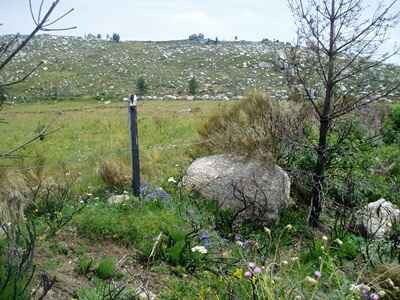 The Plan de Fontmort, located not far from our route, is a crossroads of paths that offers a diversity of possibilities. The Stevenson path continues its course through the woods, providing welcome moments of shade. The vegetation also changes, moving from the granite of Mont Lozère to the characteristic schist of the southern region. Conifers give way to other types of trees and vegetation.
The Plan de Fontmort, located not far from our route, is a crossroads of paths that offers a diversity of possibilities. The Stevenson path continues its course through the woods, providing welcome moments of shade. The vegetation also changes, moving from the granite of Mont Lozère to the characteristic schist of the southern region. Conifers give way to other types of trees and vegetation.
The GR®72 leads us from Cassagnas to Serre de la Can, an important stage of our hike. Although the Stevenson path may be less frequented than in the past, we still meet foreign hikers, mainly English and Scottish, as well as fellow French compatriots coming to discover this magnificent route. The Mas de la Frutgère hostel, run by Patrick Saintemarie, is a welcoming place for hikers, where we can get valuable information about the trail and enjoy a well-deserved rest.
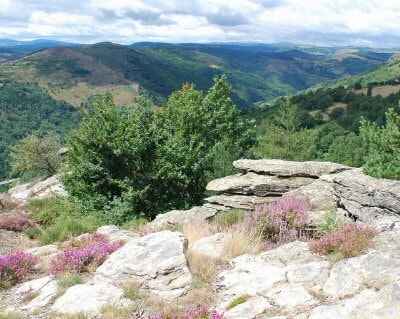 Each stage of our journey allows us to discover new landscapes, immerse ourselves in a Mediterranean atmosphere, and follow Stevenson's footsteps through the Cévennes. The Stevenson path offers a unique and enriching experience, blending nature, history, and hiking adventures.
Each stage of our journey allows us to discover new landscapes, immerse ourselves in a Mediterranean atmosphere, and follow Stevenson's footsteps through the Cévennes. The Stevenson path offers a unique and enriching experience, blending nature, history, and hiking adventures.
The end of our hike on the Stevenson path leads us through beautiful landscapes and villages steeped in history. After leaving Le Plan de Fontmort, we follow a wide trail that offers stunning views of the French valley. On our way, we pass near a large menhir, a testament to a prehistoric past and rituals related to sun worship and fertility.
As we cross the col de la Pierre Plantée, a landmark amid the woods, we slowly descend towards Serre de la Can, a holiday center with various accommodations, such as a hotel, a hostel, chalets, and a swimming pool. From there, we continue our descent to the charming village of Saint Germain de Calberte, with its Romanesque church.
Leaving Saint Germain de Calberte, we take the D 983 road towards Saint Jean du Gard. Although we try to avoid asphalt as much as possible, it may happen that we have to follow the road for a while. Along the way, it is also possible to take a one-kilometer detour to reach the Pont de Burgen hostel if one wishes to spend the night there. We then arrive at the tourist village of Saint Étienne Vallée Française, and after crossing the bridge over the Gardon, the Stevenson trail delves deeper into the countryside towards the terminus, Saint Jean du Gard, via the col de Saint Pierre.
If you plan to stay at the Marouls hostel, you will need to continue following the D 983 road. The seventh and final stage is relatively short, but it will allow you to take the bus from Saint Jean du Gard to Alès. In any case, I highly recommend traversing this part of the Cévennes. You will be enchanted by the varied landscapes, fascinating history, and the unique atmosphere of this region.
Former holiday hotel with a garden along the Allier, L'Etoile Guest House is located in La Bastide-Puylaurent between Lozere, Ardeche, and the Cevennes in the mountains of Southern France. At the crossroads of GR®7, GR®70 Stevenson Path, GR®72, GR®700 Regordane Way, GR®470 Allier River springs and gorges, GRP® Cevenol, Ardechoise Mountains, Margeride. Numerous loop trails for hiking and one-day biking excursions. Ideal for a relaxing and hiking getaway.
Copyright©etoile.fr